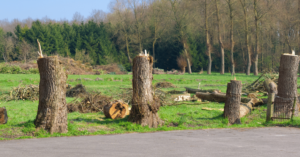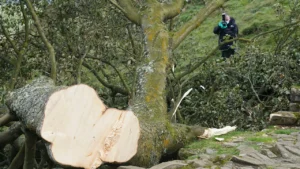When you’re faced with the decision of removing a pine tree, you might be surprised by the costs involved. Depending on factors like the tree’s height, health, and how easy it is to access, you could see prices vary considerably. For smaller trees, you might spend a few hundred dollars, but larger ones can quickly exceed thousands. Understanding these costs is essential, especially if you’re looking to budget effectively. But what should you know about the various factors influencing these expenses?
Pine Tree Removal Cost Overview
When considering pine tree removal, it’s essential to understand the range of costs involved, which can vary greatly depending on several factors.
Tree height is a significant determinant; small trees under 15 feet typically start around $150 to $350, while a 50-foot tree may cost between $890 and $1,780.
For towering trees reaching 100 feet, you’re looking at expenses ranging from $3,000 to $5,000 due to the complexity of the job.
Additionally, location accessibility plays an important role in cost calculations. If the tree’s location is hard to reach or obstructed by structures, it can increase the overall removal expense.
Therefore, evaluating these factors can help you budget effectively for your pine tree removal project.
Factors Affecting Removal Expenses
The complexity of pine tree removal arises from several key factors that influence overall costs. Tree health plays a vital role; healthy trees may require less intricate removal techniques, while diseased or damaged trees can complicate the process. Additionally, the tree’s height, trunk size, and branch spread greatly impact removal expenses.
| Factor | Impact on Cost | Notes |
|---|---|---|
| Tree Health | Higher costs for unhealthy trees | May need special techniques |
| Height | Taller trees cost more | Increased labor and equipment |
| Trunk Size | Larger trunks increase difficulty | Requires more powerful tools |
| Branch Spread | More branches can raise costs | Requires more time and effort |
| Location | Accessibility affects pricing | Hard-to-reach trees are pricier |
Understanding these factors can help you budget effectively for removal.
Average Costs by Tree Type
Understanding the average costs associated with pine tree removal varies greatly based on tree type and size. For example, conifer pine removal averages around $420, making it a popular choice among homeowners.
In contrast, Norfolk pine removal can reach about $1,990 due to its complex branching and time-consuming removal techniques. Radiata pine, known for its thickness, typically costs approximately $1,723 to remove.
The height and accessibility of these pine tree types greatly influence removal expenses. Smaller trees (up to 15 ft) may only cost around $250, while larger ones (50-100 ft) can exceed $3,000.
It’s crucial to evaluate these factors when budgeting for pine tree removal to guarantee you’re prepared for the potential costs involved.
State Variations in Pricing
State variations in pricing for pine tree removal can markedly impact your budget. Understanding regional differences is essential, as costs often reflect local economic conditions, such as the cost of living and population density.
For instance, states with higher living costs generally exhibit pricing trends that lead to increased removal fees. In contrast, areas with lower overheads may offer more competitive rates.
Additionally, the type of pine tree being removed can influence costs, as some species require more specialized equipment or labor.
By researching these variations, you can better estimate your expenses and make informed decisions about hiring tree removal services in your area.
Always gather multiple quotes to understand the pricing landscape in your state.
Discounts and Negotiation Tactics
When planning for pine tree removal, it’s important to explore potential discounts and negotiation tactics that can greatly reduce your overall costs.
Many tree removal companies offer combo deals when you’re removing multiple trees, which could save you 20% to 30%.
Use effective negotiation techniques by gathering multiple quotes from different providers, allowing you to leverage competition for better rates.
Don’t hesitate to ask about package deals, especially if your project involves several trees.
Smaller companies often have lower overheads, which could lead to more competitive pricing.
Disposal Options for Removed Trees
After you’ve negotiated a good deal for your pine tree removal, you’ll need to contemplate how to dispose of the removed trees efficiently. You have several options to weigh, particularly if you’re looking to make the most out of the timber.
| Option | Details |
|---|---|
| Firewood Usage | Cut logs to appropriate sizes for winter use. |
| Lumber Sales | Advertise usable logs on platforms like Facebook Marketplace. |
Be mindful of local demand for lumber before deciding on disposal. Firewood usage can provide warmth during colder months, while lumber sales can offset some removal costs. Each option contributes to sustainable practices and maximizes the value of your removed trees.
Cost Estimation Tools and Resources
Utilizing cost estimation tools can considerably streamline your budgeting process for pine tree removal. Cost calculators are valuable resources that assess various factors, including tree size, location, and removal complexity.
By inputting specific details about your pine tree, these calculators provide a tailored estimate, helping you avoid unexpected expenses. Implementing effective budgeting strategies alongside these tools guarantees you allocate funds accurately.
Additionally, comparing quotes from multiple service providers can enhance your understanding of average costs in your area. Remember, the more informed you’re about potential expenses, the better prepared you’ll be to negotiate and make decisions.
Utilizing these resources can save you both time and money during your pine tree removal project.
Conclusion
In summary, while the cost of pine tree removal can feel overwhelming, remember that investing in safety and property value is invaluable. On one hand, the financial burden might seem intimidating; on the other, the peace of mind from eliminating a potential hazard is priceless. By understanding the factors at play and exploring your options, you can navigate this process wisely, ensuring that your investment leads to a safer, more beautiful environment for you and your loved ones.



